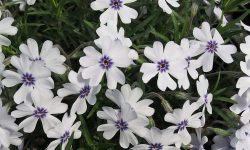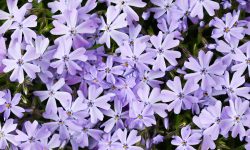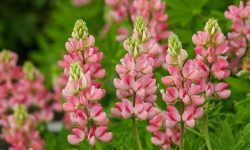Summer fills American gardens with warmth, brightness, and endless beauty. Across the country, gardeners celebrate the season by planting flowers that thrive under golden sunlight. Each bloom adds life, texture, and color, turning ordinary yards into vibrant summer escapes. These flowers don’t just decorate — they define the feeling of summer.
From coastal California to the green hills of Vermont, summer flowers bring excitement to every landscape. Some prefer intense sunlight, while others shine in gentle shade. Their colors range from fiery reds and sunny yellows to soft pinks and purples that glow in the heat. Each one attracts butterflies, bees, and hummingbirds, adding energy to the garden. In this guide, you’ll discover twelve summer flowers that keep your garden alive with color and charm all season long.
Sunflower (Helianthus annuus)
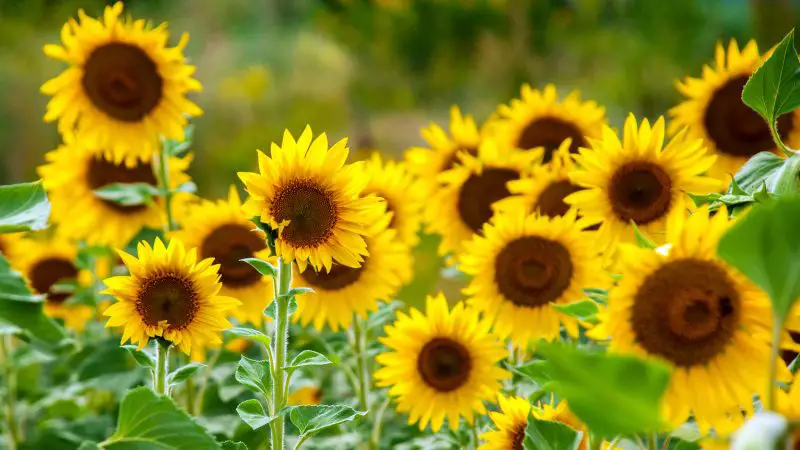
The sunflower is one of the most radiant symbols of summer. With tall stems, golden petals, and cheerful faces, it reflects warmth and light wherever it grows. Belonging to the Asteraceae family, it’s easy to recognize by its large round center filled with seeds and surrounded by glowing yellow or orange rays. Sunflowers grow quickly from seed and flourish in wide, sunny spaces. Their simple beauty and bold color make them garden favorites, admired for both strength and charm.
Interestingly, sunflower varieties differ greatly in size and appearance. Dwarf types such as ‘Teddy Bear’ and ‘Sunspot’ reach only 12 to 24 inches tall, perfect for pots or borders. In contrast, giant types like ‘Mammoth’ can grow over 10 feet high, forming dramatic natural screens. Bloom colors range from classic golden yellow to orange, bronze, and creamy white. Typically, they flower from midsummer to early fall, brightening gardens for weeks. Each bloom gracefully follows the sun’s movement—a fascinating behavior called heliotropism.
Moreover, sunflowers thrive in USDA zones 4 through 9, preferring full sun and well-drained, slightly alkaline soil. Once established, they withstand heat and short dry spells easily. Their adaptability makes them ideal for climates across the United States, from the prairies of Kansas to coastal California. Even after flowering, their seeds attract birds and add life to the garden.
To grow them successfully, sow seeds outdoors after frost ends. Space them 12 to 18 inches apart and water deeply once a week. Add mulch to conserve moisture and deter weeds. For tall varieties, provide gentle staking to support heavy blooms. With minimal care and plenty of sunshine, sunflowers bloom steadily all season, filling gardens with golden color, joyful energy, and the timeless beauty of summer.
Black-eyed Susan (Rudbeckia hirta)

Black-eyed Susan is one of the most iconic wildflowers in American gardens. Its golden-yellow petals and dark brown centers create a cheerful, sunlit display that captures the essence of summer. Belonging to the daisy family (Asteraceae), it brings warmth and rustic charm to every landscape. Each flower features a raised, cone-shaped center surrounded by glowing petals that seem to shimmer under the summer sun. This hardy, low-maintenance plant thrives in meadows, fields, and home gardens alike, symbolizing the spirit of the open American prairie.
This dependable perennial, often treated as an annual in colder areas, reaches 1 to 3 feet tall with an 18-inch spread. It has sturdy green stems and lance-shaped leaves that give structure to garden beds. Blooming begins in early summer and continues into fall, keeping gardens bright through the hottest months. The most common color is golden yellow, though some cultivars show orange, rust, or deep red tones. Popular varieties like ‘Goldsturm’ and ‘Indian Summer’ are loved for their large blooms and long-lasting beauty.
Black-eyed Susan thrives in USDA zones 3 through 9. It prefers full sunlight and moderately fertile, well-drained soil. Once established, it tolerates drought and heat with ease. The plant resists deer and attracts pollinators like bees, butterflies, and goldfinches that feed on its seeds. Its resilience makes it ideal for both rural and suburban gardens.
To grow, sow seeds outdoors after frost or transplant young plants into prepared beds. Space them 12 to 18 inches apart for airflow. Water regularly until roots form, then reduce watering to prevent rot. Deadhead faded blooms to encourage new flowers. With minimal care, Black-eyed Susans return each year, filling gardens with glowing color and classic American charm.
Coneflower (Echinacea purpurea)
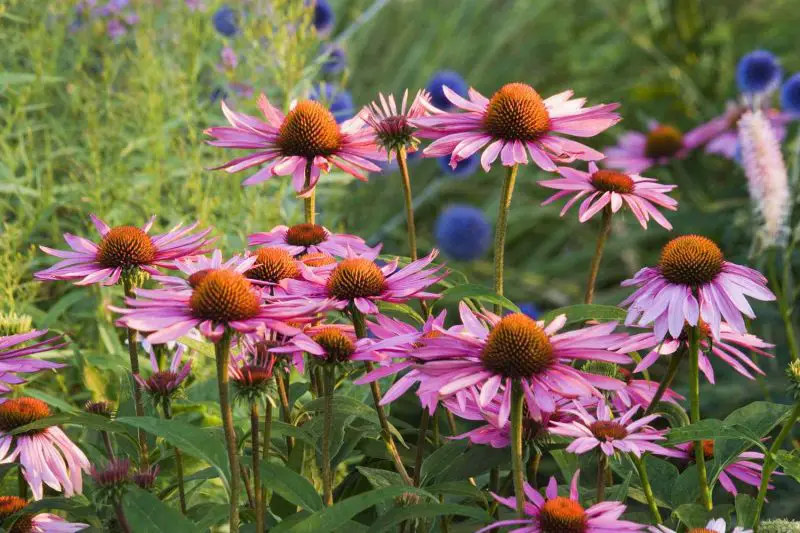
Coneflower, or Echinacea purpurea, is one of America’s most recognizable summer perennials. Its daisy-like blooms with raised centers bring bold color and texture to gardens. Native to the central and eastern United States, it thrives in sunny, open spaces. With strong stems and radiant petals, coneflowers combine beauty and endurance. Gardeners love them for their easy care, long bloom time, and natural ability to attract pollinators. Known for their herbal value, coneflowers are also used in teas and remedies that support immune health.
Most coneflowers grow between 2 and 4 feet tall and form neat, clumping mounds. Their petals curve gently around a bronze or orange cone that glows in the sun. Common colors include purple, pink, white, orange, and yellow, depending on the variety. The classic Echinacea purpurea displays vivid purple petals and deep brown centers. Blooms appear from early summer through fall, providing steady color when many flowers fade. Even after flowering, seed heads attract finches and other birds, keeping the garden alive with motion.
Coneflowers grow best in USDA zones 3 through 9. They prefer full sunlight and well-drained soil but tolerate partial shade and drought once mature. Their deep roots retain moisture and resist summer heat, making them reliable across climates—from the Midwest plains to southern gardens. These sturdy plants rarely need fertilizer and thrive even in poor soil.
Plant coneflowers in spring after frost. Space them 18 to 24 inches apart for airflow and water weekly until roots develop. Deadhead spent flowers to promote reblooming. In fall, leave some seed heads for birds and winter texture. With little effort, coneflowers return each year, bringing lasting color, resilience, and the simple charm of summer.
Shasta Daisy (Leucanthemum × superbum)
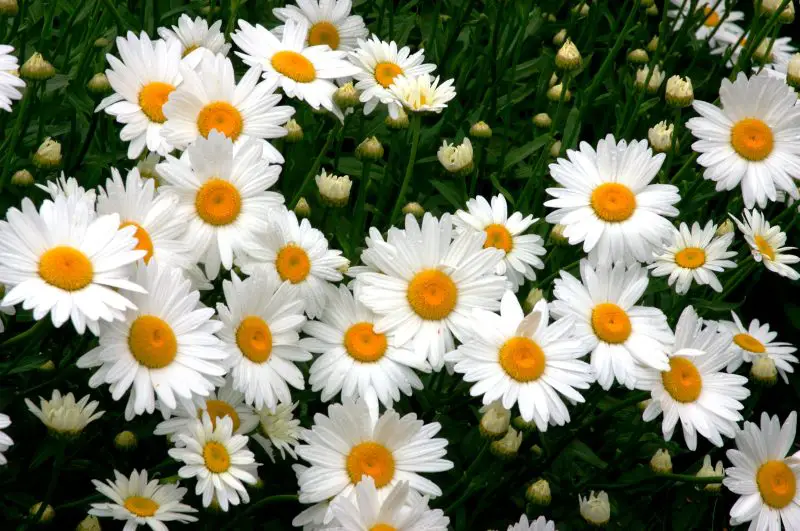
The Shasta daisy is a beloved summer flower that brightens gardens with white petals and sunny yellow centers. This cheerful perennial combines simple beauty with strength and reliability. A member of the Asteraceae family, it thrives in bright, open areas. Shasta daisies bring a clean, classic look to borders, beds, and cottage gardens. Their fresh color and sturdy nature make them one of the most dependable summer blooms. Named after Mount Shasta in California, this flower reflects the brightness and calm of the season.
Mature plants usually grow 2 to 3 feet tall and form neat mounds of glossy green leaves. Each stem holds a single flower about 3 inches wide, with a golden center surrounded by crisp white petals. Blooms appear in early summer and last into late August. With proper deadheading, they may continue into fall. Varieties like ‘Becky,’ ‘Alaska,’ and ‘Snowcap’ are favorites for their strong stems, abundant blooms, and long vase life. Their sunny faces add light and structure to every garden setting.
Shasta daisies grow best in USDA zones 5 through 9. They prefer full sun and well-drained soil with moderate fertility. Once established, they handle heat and short droughts easily. These perennials attract bees and butterflies but resist deer, making them both practical and beautiful. Their ability to thrive in different climates makes them ideal for many American gardens.
To grow successfully, plant Shasta daisies in spring or early fall, spacing them 18 to 24 inches apart. Water young plants weekly until they root firmly, then only during long dry spells. Remove spent blooms to extend flowering. Cut stems to the base after blooming and divide clumps every few years. With minimal care, Shasta daisies bring pure color and timeless summer beauty.
Zinnia (Zinnia elegans)
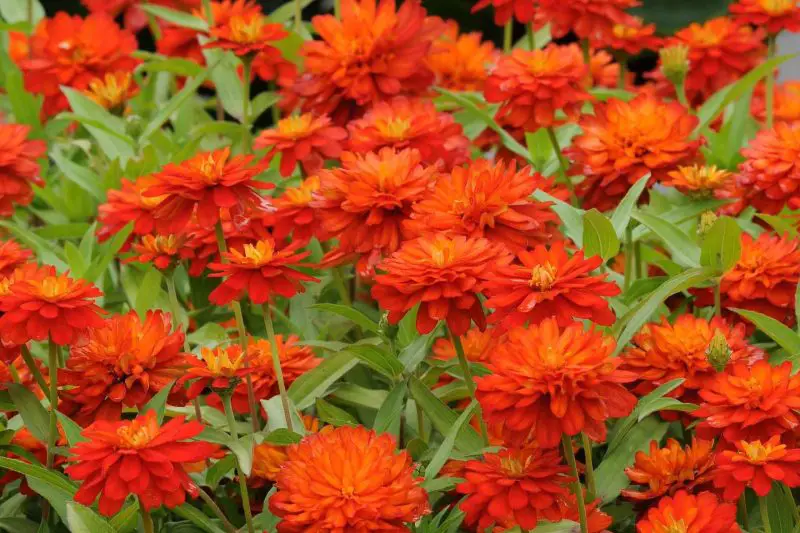
Zinnia is a vibrant, sun-loving annual that brings unmatched color and joy to American summer gardens. With its bold blooms and endless color choices, it captures the lively spirit of the season. Native to Mexico and Central America, zinnia thrives in hot weather and open sunlight, making it perfect for U.S. gardens from coast to coast. Its low-maintenance nature and rapid growth make it a favorite for both beginners and experienced gardeners. Zinnias add instant brightness to borders, flower beds, and containers, turning any outdoor space into a cheerful summer display.
Most zinnias grow between 1 and 3 feet tall, depending on the variety. Compact types like ‘Profusion’ and ‘Thumbelina’ are ideal for small spaces, while taller varieties such as ‘State Fair’ and ‘Benary’s Giant’ produce large, dazzling blooms up to 6 inches wide. Petal shapes vary—some are flat and daisy-like, others dome-shaped or double-layered like pom-poms. Colors range from scarlet, pink, orange, and yellow to lavender, white, and even bicolor blends. Blooming begins in late spring and continues until frost, ensuring months of nonstop color.
Zinnias thrive in USDA zones 2 through 11, performing best in full sun and fertile, well-drained soil. They need warm temperatures to germinate and grow quickly once established. These flowers tolerate heat but dislike humidity and poor airflow, which can cause powdery mildew. Regular deadheading keeps them blooming and encourages stronger growth. Zinnias also attract butterflies, bees, and hummingbirds, bringing extra life and motion to the garden.
To plant zinnias, sow seeds directly outdoors after the last frost. Space them 8 to 12 inches apart for airflow. Water deeply but infrequently to prevent mildew. Avoid overhead watering to keep foliage dry. With sunlight, warmth, and occasional feeding, zinnias reward gardeners with brilliant, long-lasting blooms that define the joy and energy of summer.
Marigold (Tagetes spp.)

Marigold is a classic summer flower that fills American gardens with warmth, color, and energy. Known for its golden, orange, and coppery blooms, this cheerful annual thrives under bright sun and heat. Native to Mexico and Central America, marigold has long symbolized brightness and protection. Its vibrant flowers and aromatic foliage make it both decorative and useful. Many gardeners plant marigolds to repel pests and attract pollinators, creating a healthier garden ecosystem. With little effort, they bloom nonstop from early summer until frost, bringing joy to every corner of the yard.
Marigolds come in many forms and sizes. African marigolds (Tagetes erecta) grow up to 3 feet tall and produce large, round flowers. French marigolds (Tagetes patula) stay compact at about 12 inches, making them perfect for edging or pots. Signet marigolds (Tagetes tenuifolia) have smaller, single flowers but an abundance of blooms. Their colors range from rich gold and deep orange to red and creamy yellow, sometimes with bicolor patterns. The petals’ texture—sometimes ruffled, sometimes flat—adds depth and charm to garden displays.
Marigolds thrive in USDA zones 2 through 11 and love full sunlight. They grow best in moderately fertile, well-drained soil. These plants handle drought and heat with ease once established but prefer consistent moisture during growth. Avoid overwatering, as soggy soil can cause root rot. Marigolds also deter common garden pests like nematodes, aphids, and whiteflies, making them perfect companions for vegetables and herbs.
To grow marigolds, sow seeds directly after frost or plant seedlings once the soil warms. Space them 8 to 12 inches apart for good airflow. Water regularly but lightly. Remove faded blooms to keep flowers coming. With minimal care, marigolds flourish all summer, rewarding you with bright, sunlit color and a touch of classic garden magic.
Lantana (Lantana camara)

Lantana is a vibrant summer favorite that brings dazzling color and resilience to American gardens. Native to tropical regions of the Americas, this sun-loving perennial (often grown as an annual in cooler areas) thrives in heat and poor soil where few other flowers can. Its clusters of tiny, multicolored blooms create a kaleidoscope of red, orange, yellow, pink, and purple shades that change as the flowers mature. Lantana blooms nonstop from late spring through fall, attracting butterflies, bees, and hummingbirds to every sunny corner of the garden.
Mature lantana plants typically reach 1 to 3 feet tall, with a spreading, bushy habit that makes them ideal for garden borders, hanging baskets, or ground covers. Their textured, deep-green leaves release a distinct fragrance when touched, naturally repelling deer and some pests. Each flower cluster combines several colors, giving lantana a lively, ever-changing look. Varieties such as ‘New Gold,’ ‘Miss Huff,’ and ‘Confetti’ are popular for their rich hues and strong performance throughout the hottest months. Even in dry, coastal, or sandy areas, lantana continues to bloom beautifully.
Lantana grows best in USDA zones 8 through 11 but can be treated as an annual in cooler regions. It prefers full sun and well-drained soil, tolerating drought once established. Excess watering or rich soil can reduce blooming, so moderate care works best. Its heat tolerance and low maintenance make it an ideal choice for xeriscapes and coastal gardens. Regular trimming helps maintain shape and encourages continuous flowering.
To grow lantana, plant it in spring after frost has passed. Space plants 12 to 18 inches apart to allow airflow. Water deeply but infrequently. Deadhead faded blooms to promote new ones and prune lightly through summer for fullness. With minimal effort, lantana fills gardens with glowing color, movement, and the bright energy of a Southern summer.
Blanket Flower (Gaillardia pulchella)
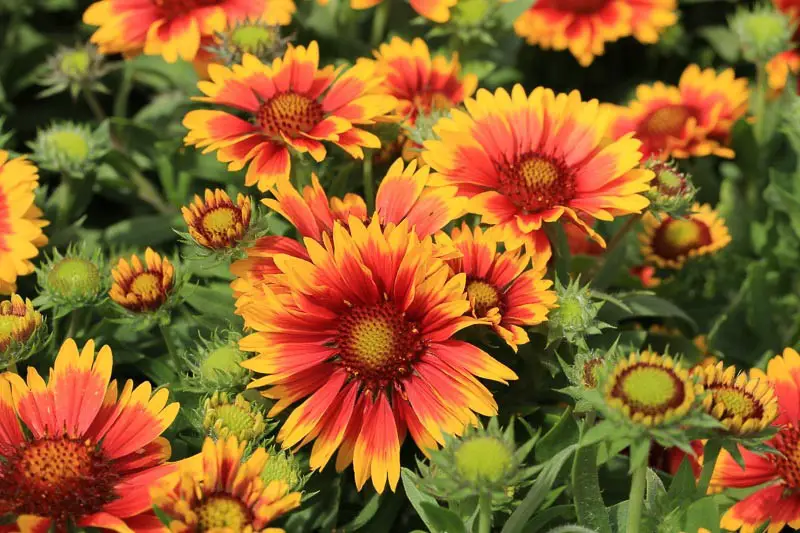
Blanket flower, or Gaillardia pulchella, is a striking summer perennial known for its fiery colors and effortless charm. Native to North America, it paints gardens with shades of red, orange, and yellow that resemble a glowing sunset. The name “blanket flower” comes from its warm, woven-like color patterns, reminiscent of Native American blankets. It thrives under the hot sun, tolerates dry soil, and blooms nonstop from early summer until frost. This cheerful, low-maintenance plant adds long-lasting color to borders, wildflower gardens, and dry landscapes alike.
Mature blanket flowers typically grow 12 to 24 inches tall with a spread of about 18 inches. Their daisy-like blooms feature scarlet centers that fade outward into orange and gold tips. Petals can be flat, frilled, or tubular depending on the variety. Popular cultivars like ‘Arizona Sun,’ ‘Goblin,’ and ‘Mesa Yellow’ are loved for their vivid colors and extended bloom time. Each flower lasts for several days, and with regular deadheading, the plant continues to produce new buds all season. Even when other flowers fade in heat, blanket flower keeps shining.
Blanket flowers perform best in USDA zones 3 through 10. They love full sunlight and dry, sandy, or rocky soil with good drainage. Overly rich soil can reduce blooms, so avoid heavy fertilizing. Once established, they handle drought with ease and require little watering. These plants also resist deer and attract bees and butterflies, making them both hardy and wildlife-friendly. Their deep roots help them thrive in poor soil and coastal gardens where other plants may struggle.
To grow blanket flowers, plant them in spring or early summer. Space each plant 12 to 15 inches apart for airflow. Water lightly but consistently during establishment, then only during prolonged drought. Remove spent blooms to encourage reblooming and cut plants back in late fall. With simple care, blanket flowers deliver radiant color and wild beauty from summer’s start to its final golden days.
Petunia (Petunia hybrida)
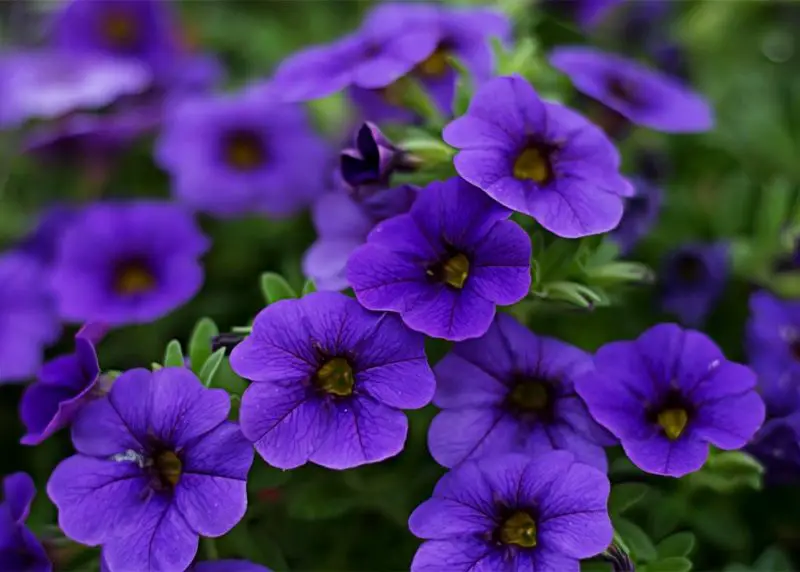
Petunia is one of the most beloved summer flowers, famous for its vivid colors, gentle fragrance, and long blooming season. Native to South America, it thrives in warm, sunny climates and brings effortless beauty to gardens across the United States. With trumpet-shaped flowers that come in every shade—from deep purple to pink, red, yellow, and white—petunias can brighten any landscape. They bloom continuously from late spring through fall, spreading color across beds, containers, and hanging baskets. Their resilience and constant flowering make them a symbol of cheerful summer gardens.
Mature petunia plants usually grow 6 to 18 inches tall, depending on the variety. Grandiflora types feature large, showy blooms ideal for containers, while multiflora and milliflora varieties produce smaller flowers that hold up better in wind and rain. Spreading types, such as ‘Wave’ and ‘Supertunia,’ create lush cascades of color that trail beautifully over pots and borders. The funnel-shaped blossoms attract hummingbirds and pollinators, adding motion and life to every sunny space. With regular care, petunias bloom nonstop until the first frost.
Petunias thrive in USDA zones 9 through 11 but are often grown as annuals in cooler regions. They prefer full sun and fertile, well-drained soil. Good air circulation helps prevent mildew, while moderate watering keeps roots healthy. Avoid overwatering, as soggy soil can cause rot. Petunias handle heat well and recover quickly after rain, making them ideal for busy gardeners. Light feeding every few weeks promotes continuous blooms and lush foliage throughout the season.
To grow petunias, plant them outdoors after frost has passed. Space them 10 to 12 inches apart for even spreading. Water deeply when the top inch of soil feels dry, and remove spent flowers to encourage new blooms. Trim leggy stems midseason to maintain shape. With sunlight, warmth, and simple care, petunias reward every gardener with vibrant color, fragrance, and the true joy of summer.
Hibiscus (Hibiscus rosa-sinensis)

Hibiscus is one of the most striking summer flowers, celebrated for its large, tropical blooms and bold presence. Native to Asia but beloved across America, this vibrant plant adds an exotic touch to gardens, patios, and sunny landscapes. Its wide, trumpet-shaped flowers bloom in brilliant shades of red, pink, orange, yellow, and white. Each blossom opens fully for just a day, yet the plant continues to bloom all summer. With lush, glossy leaves and colorful petals, hibiscus creates a tropical atmosphere wherever it grows.
Most hibiscus plants reach 4 to 8 feet tall, depending on the variety. Tropical types like Hibiscus rosa-sinensis thrive in warm, humid areas, while hardy species such as Hibiscus moscheutos can withstand colder climates. The blooms can measure up to 8 inches across, with dramatic stamens that extend outward. Popular cultivars like ‘Red Heart,’ ‘Luna Pink Swirl,’ and ‘Brilliant’ showcase vivid color and impressive size. The flowers attract butterflies and hummingbirds, bringing energy and life to any summer garden.
Hibiscus grows best in USDA zones 9 through 11 but can be grown as an annual or container plant in cooler regions. It prefers full sunlight and rich, well-drained soil that stays consistently moist. Water deeply two to three times a week during hot weather, but avoid waterlogged roots. Adding mulch helps keep the soil cool and retain moisture. Regular pruning encourages branching and new blooms. Fertilize every two weeks with a balanced formula to support constant flowering.
To grow hibiscus successfully, plant it in spring once frost has passed. Space plants 3 to 4 feet apart to allow air circulation. Water regularly, and remove spent flowers to extend blooming. Bring container-grown hibiscus indoors before frost in northern zones. With warmth, sunlight, and consistent care, hibiscus rewards gardeners with stunning tropical color and a radiant, long-lasting summer display.
Salvia (Salvia splendens)
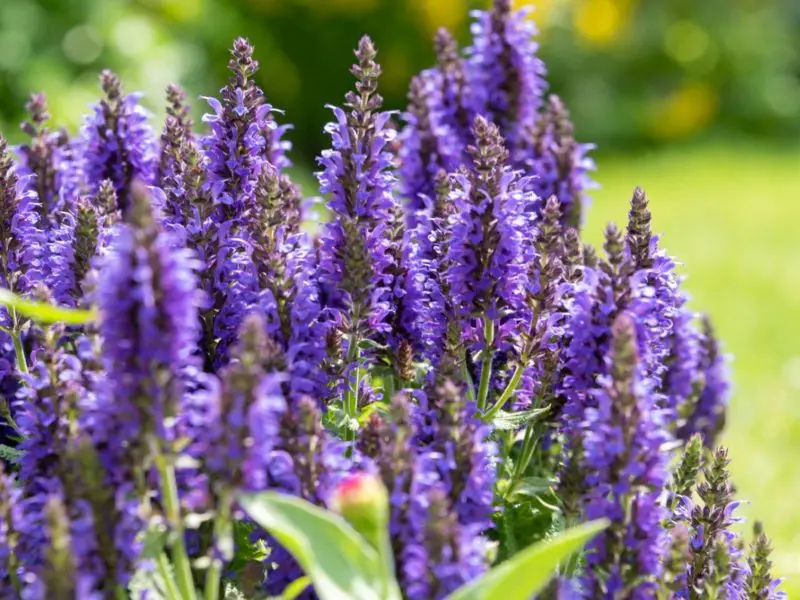
Salvia, also known as scarlet sage, is a bold and dependable summer flower that lights up American gardens with brilliant color. Native to Brazil, it thrives in warm, sunny weather and is loved for its dense spikes of red, purple, blue, or white blooms. The plant’s upright form and long flowering season make it ideal for garden borders, mass plantings, and pollinator gardens. From early summer until frost, salvia delivers continuous color and movement, attracting hummingbirds, bees, and butterflies. It’s a staple for those who want low-maintenance brilliance that lasts all season.
Most salvia plants grow 12 to 36 inches tall, forming neat, bushy mounds of dark green foliage. The tubular flowers rise in vertical clusters above the leaves, creating a strong contrast of texture and color. Classic varieties like ‘Vista Red,’ ‘Salsa Purple,’ and ‘Bonfire’ are garden favorites for their vibrant hues and compact growth. Perennial types such as Salvia nemorosa and Salvia guaranitica return year after year, while Salvia splendens is often grown as an annual for nonstop summer blooms. Whatever the type, salvia adds height and structure to flower beds with elegant ease.
Salvia thrives in USDA zones 8 through 10 but adapts easily to most U.S. climates when treated as an annual. It prefers full sun and well-drained soil with moderate fertility. Once established, it handles heat and drought well. Overwatering can reduce blooming, so allow the soil to dry slightly between watering sessions. These hardy plants are deer-resistant and naturally repel pests, making them perfect for sustainable, low-maintenance gardens.
To grow salvia, plant it outdoors after the last frost. Space plants 12 to 18 inches apart to encourage airflow. Water weekly until roots are established, then only during dry spells. Deadhead spent flowers to promote new spikes, and feed lightly every month for stronger growth. With bright sunlight and steady care, salvia fills gardens with vibrant color, grace, and a constant hum of life all summer long.
Lavender (Lavandula angustifolia)

Lavender is one of the most cherished summer flowers, loved for its calming scent, silvery foliage, and elegant purple blooms. Native to the Mediterranean, it thrives under full sunlight and dry, well-drained soil, making it perfect for many American gardens. Its fragrant blossoms fill the air with a soothing aroma that defines summer serenity. Beyond beauty, lavender offers practicality — it repels pests, attracts pollinators, and can be used for crafts, teas, or essential oils. With its grace and resilience, lavender turns any landscape into a peaceful, colorful retreat.
Mature lavender plants grow 1 to 3 feet tall, forming compact, rounded mounds. Their slender stems hold spikes of tiny purple or violet flowers that sway gently in the breeze. Popular varieties such as ‘Hidcote,’ ‘Munstead,’ and ‘Phenomenal’ are prized for their color intensity and strong fragrance. Blooming typically begins in late spring and continues through midsummer, with a lighter rebloom in early fall. Even after flowering, the silver-green leaves maintain structure and beauty, providing year-round interest.
Lavender grows best in USDA zones 5 through 9, thriving in warm days and cool nights. It prefers sandy or rocky soil with excellent drainage. Excess moisture is its biggest enemy, so avoid heavy clay or overwatering. Once established, lavender tolerates drought and heat with ease. These hardy plants also resist deer and many common pests. Their nectar-rich blooms attract bees and butterflies, making them a natural choice for pollinator gardens and eco-friendly landscapes.
To grow lavender, plant it in spring after frost has passed. Space plants 18 to 24 inches apart to allow airflow and prevent mildew. Water deeply but infrequently, and trim lightly after blooms fade to encourage reblooming. Avoid high-nitrogen fertilizer, which promotes leaf growth over flowers. With sunlight, patience, and gentle care, lavender rewards you with color, fragrance, and a timeless touch of summer tranquility.
Conclusion
Summer gardens across America burst with life, color, and fragrance thanks to these twelve radiant flowers. From the golden glow of sunflowers to the soothing scent of lavender, each bloom tells a story of warmth, resilience, and natural beauty. These flowers don’t just decorate — they transform ordinary spaces into living canvases alive with movement and light. Whether you love bold colors or gentle tones, there’s a summer flower perfectly suited to your garden. With sunlight, care, and a touch of passion, these blooms will keep your garden glowing and your spirit lifted all season long.


